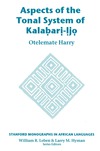This book breaks new ground in language studies with its detailed
analysis of the relatively unknown Nigerian language
Kalaḅarị-Ịjọ. A language from the Niger-Congo region,
Kalaḅarị-Ịjọ contains puzzling tonal configurations that have
so far eluded researchers' efforts to create coherent descriptive
analyses.
This study determines that right-to-left association is
the best method of analysis for Kalaḅarị-Ịjọ and also proposes
that both morphosyntactic and semantic input be included in
the tone system rules. Otelemate Harry's innovative work
provides new evidence for morphological and semantic input in
phonology theory and launches a new platform of scholarship
in African languages studies.
Otelemate Harry is lecturer of linguistics at the University
of the West Indies, Mona Campus, Jamaica.
- Preface
- 1 Introduction
- 1.0 Preliminary Remarks
- 1.1 The Speakers and Their Location
- 1.2 Kalaḅarị in Ịjọ Classification
- 1.3 Kalaḅarị Literature
- 1.4 Kalaḅarị Segmental Phonology
- 1.4.1 Vowel System
- 1.4.1.1 ATR Harmony
- 1.4.1.2 Surface Vowel Deletion
- 1.4.1.3 Sequentially Occurring Identical Vowels
- 1.4.2 Consonant System
- 1.4.2.1 Implosive Harmony
- 1.4.2.2 Homorganic Nasal
- 1.5 Syllable Structures and Types
- 1.6 Aspects of Kalaḅarị Morphology and Syntax
- 1.6.1 Classification of Kalaḅarị Morphemes
- 1.6.1.1 Lexical Morphemes
- 1.6.1.2 Grammatical Morphemes
- 1.6.2 Basic Word Order
- 1.6.2.1 INFL (IP) Phrase
- 1.6.2.2 Verb Phrase (VP)
- 1.6.2.3 Determiner (DP)
- 1.6.2.4 Noun Phrase (NP)
- 1.7 Summary
- 2 Lexical Tonology
- 2.0 Introduction
- 2.1 Kalaḅarị Tone System
- 2.1.1 The Pitch Levels
- 2.1.2 Contour Tones
- 2.1.3 Tone Bearing Units in Kalaḅarị
- 2.2 Surface Tone Patterns in Morphemes
- 2.2.1 Monosyllabic Items
- 2.2.2 Bisyllabic Items
- 2.2.3 Trisyllabic Items
- 2.2.4 Quadsyllabic Items
- 2.2.5 Summary of Surface Tone Patterns
- 2.3 The Analysis of Kalaḅarị Tone
- 2.3.1 Lexical Phonology
- 2.3.2 Autosemental Phonology
- 2.3.3 CV Phonology
- 2.3.4 Options for Representing Underlying Tones
- 2.4 Tone Mapping in Kalaḅarị
- 2.4.1 Tone Mappying in Patterns without Floating Tone
- 2.4.2 Tone Mapping in Patterns with Floating L Tone
- 2.4.2.1 Patterns with Floating L Tone before Final Syllable
- 2.4.2.2 Patterns with Floating L Tone before Penultimate Syllable
- 2.5 Analysis of Tonal Patterns Exclusive to Loanwords
- 2.6 Summary
- 3 Phrasal Tonology
- 3.0 Introduction
- 3.1 Tone Reduction
- 3.2 Tone Phrase Information
- 3.3 Effects of Morphological Class on Tone Phrases
- 3.3.1 Tone Phrases Determined by TM1 Only
- 3.3.2 Tone Phrases with L Tone Melody
- 3.3.3 Tone Phrases with H Tone Melody
- 3.3.4 Tone Phrases with HL Tone Melody
- 3.3.5 Tone Phrases with HLH Tone Melody
- 3.3.5.1 Non-Intimate Possessive Pronoun + Noun
- 3.3.5.2 Distal Demonstrative + Noun
- 3.4 Tone Processes in Seuences Larger Than Two Items
- 3.4.1 Three and Four-word Sequences with L Tone Melody
- 3.4.2 Three and Four-word Sequences with H Tone Melody
- 3.4.3 Three and Four-word Sequences with HL Tone Melody
- 3.4.4 Three and Four-word Sequences with HL and H Tone Melody
- 3.5 Summary
- 4 Syntactic Domains of Tone Phrase
- 4.0 Introduction
- 4.1 Syntactic Phrases in which TD Applies
- 4.2 Syntactic Phrases in which TD does not Apply
- 4.3 Tone Deletion Rule (Revised)
- 4.4 Summary
- 5 Conclusions
- 5.0 Introduction
- 5.1 Tone Association
- 5.1.1 Segmental Processes and Tone Association
- 5.2 Syntax and Phrase Tonology
- 5.3 OCP and Phrase Tonology
- 5.4 Concluding Remarks
- Appendix
- References
6/1/2004
ISBN (Paperback): 1575864827 (9781575864822)
ISBN (Electronic): 1575866897 (9781575866895)


